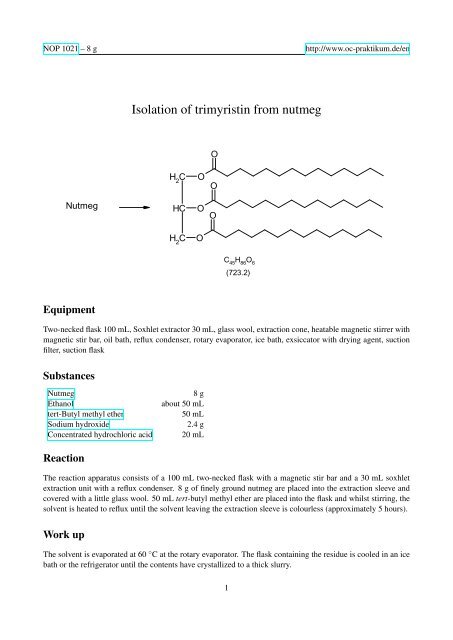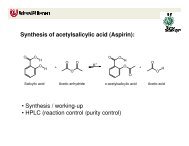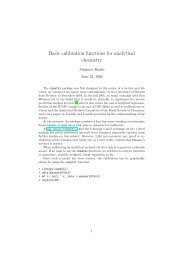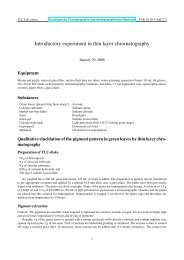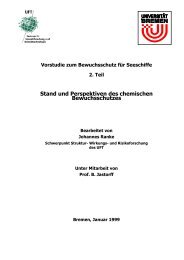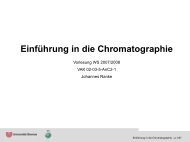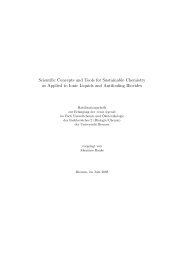Isolation of trimyristin from nutmeg
Isolation of trimyristin from nutmeg
Isolation of trimyristin from nutmeg
You also want an ePaper? Increase the reach of your titles
YUMPU automatically turns print PDFs into web optimized ePapers that Google loves.
NOP 1021 – 8 ghttp://www.oc-praktikum.de/en<strong>Isolation</strong> <strong>of</strong> <strong>trimyristin</strong> <strong>from</strong> <strong>nutmeg</strong>ONutmegH 2CHCOOOOC H 2OC 45H 86O 6(723.2)EquipmentTwo-necked flask 100 mL, Soxhlet extractor 30 mL, glass wool, extraction cone, heatable magnetic stirrer withmagnetic stir bar, oil bath, reflux condenser, rotary evaporator, ice bath, exsiccator with drying agent, suctionfilter, suction flaskSubstancesNutmegEthanoltert-Butyl methyl etherSodium hydroxideConcentrated hydrochloric acid8 gabout 50 mL50 mL2.4 g20 mLReactionThe reaction apparatus consists <strong>of</strong> a 100 mL two-necked flask with a magnetic stir bar and a 30 mL soxhletextraction unit with a reflux condenser. 8 g <strong>of</strong> finely ground <strong>nutmeg</strong> are placed into the extraction sleeve andcovered with a little glass wool. 50 mL tert-butyl methyl ether are placed into the flask and whilst stirring, thesolvent is heated to reflux until the solvent leaving the extraction sleeve is colourless (approximately 5 hours).Work upThe solvent is evaporated at 60 ◦ C at the rotary evaporator. The flask containing the residue is cooled in an icebath or the refrigerator until the contents have crystallized to a thick slurry.1
NOP 1021 – 8 ghttp://www.oc-praktikum.de/enCrude product yield: 4 gThe crude product is recrystallized <strong>from</strong> a small amount <strong>of</strong> ethanol. Prior to filtering the crystals, the flaskis placed into the refrigerator for at least 30 minutes. The crystalline slurry is filtered and the product is driedin an evacuated desiccator over silica gel. Should the crystals not be colourless after the first recrystallization,a second recrystallization is carried out.Yield: 2 g; melting point 54-55 ◦ CHydrolysis <strong>of</strong> the triglyceride0.3 g <strong>of</strong> the product are placed into a 100 mL round-bottom flask. 10 mL <strong>of</strong> a 6 M sodium hydroxide solutionin water are added with the necessary safety precautions. Then, 10 mL ethanol are added and the solution isheated slightly under reflux for one hour. If ethanol is lost, it has to be refilled aproximately to the level at thestart <strong>of</strong> the reaction.The solution is poured into 100 mL water in a large beaker. After addition <strong>of</strong> 20 mL concentrated hydrochloricacid, a solid white product is formed, which is filtered, washed with 5 mL <strong>of</strong> water and dried.Analysis <strong>of</strong> the fatty acidsApproximately 10 mg <strong>of</strong> the product <strong>of</strong> the hydrolysis are placed in a 100 mL measuring flask. Fill up with50 mL <strong>of</strong> methanol and 50 mL <strong>of</strong> water. Calculate the approximate molarity <strong>of</strong> the solution, assuming it is puretetradecanoic acid (synonymous to myristic acid).Calculate the nominal mass <strong>of</strong> myristic acid and <strong>of</strong> similar fatty acids that you might expect in your product.What kind <strong>of</strong> isotope patterns do you expect?A mass spectrum <strong>of</strong> the dissolved fatty acids in solution is generated with the mass spectrometer withelectron spray interface (ESI). Include spectra in positive and negative mode in your report and discuss everypeak, even if you are not sure what it is.Duration <strong>of</strong> the experimentTwo daysWhere can I stop the experimentBefore and after the evaporation <strong>of</strong> the solventRecyclingThe evaporated tert-butyl methyl ether and the evaporated ethanol <strong>from</strong> the mother liquor are collected andredistilled.2
NOP 1021 – 8 ghttp://www.oc-praktikum.de/enSuggestions for waste disposalWasteresidue <strong>from</strong> mother liquorresidue <strong>from</strong> extractionDisposaldomestic wastedomestic wasteQuestions1. What are the main sources <strong>of</strong> hazard for health and environment in the experiment?2. What do you have to keep in mind when setting up the glass apparatus?3. What are the advantages <strong>of</strong> a soxhlet extractor in comparison to a simple extraction e.g. in a round-bottomflask?4. What active substance(s) are in <strong>nutmeg</strong>? What kind <strong>of</strong> effects do they have on humans upon ingestion?Where would you expect to find them after the experiment?5. Please write down the mechanism <strong>of</strong> the ester hydrolysis.6. Where does the glycerin go?7. Answer the questions regarding the MS analysis above.3


